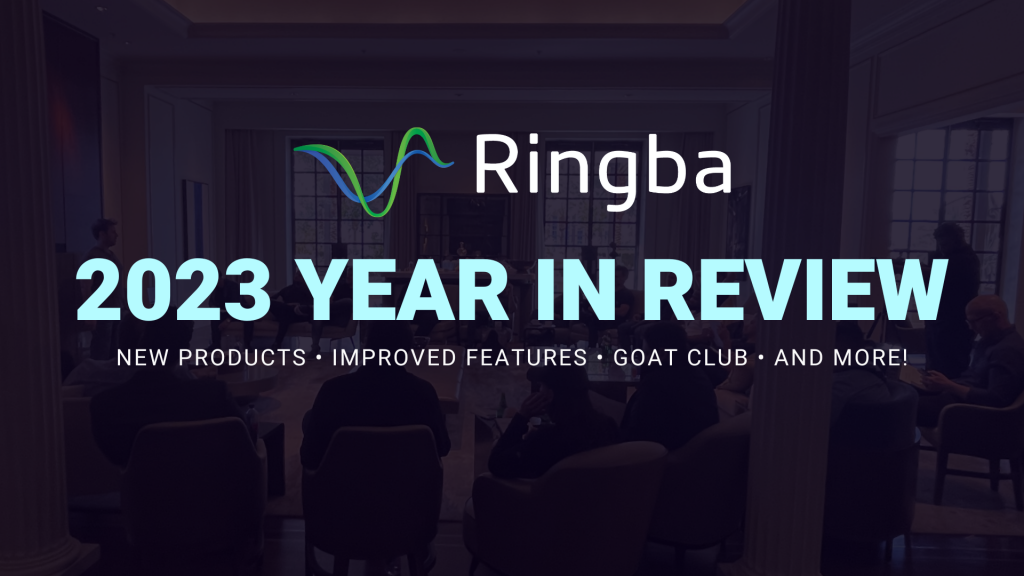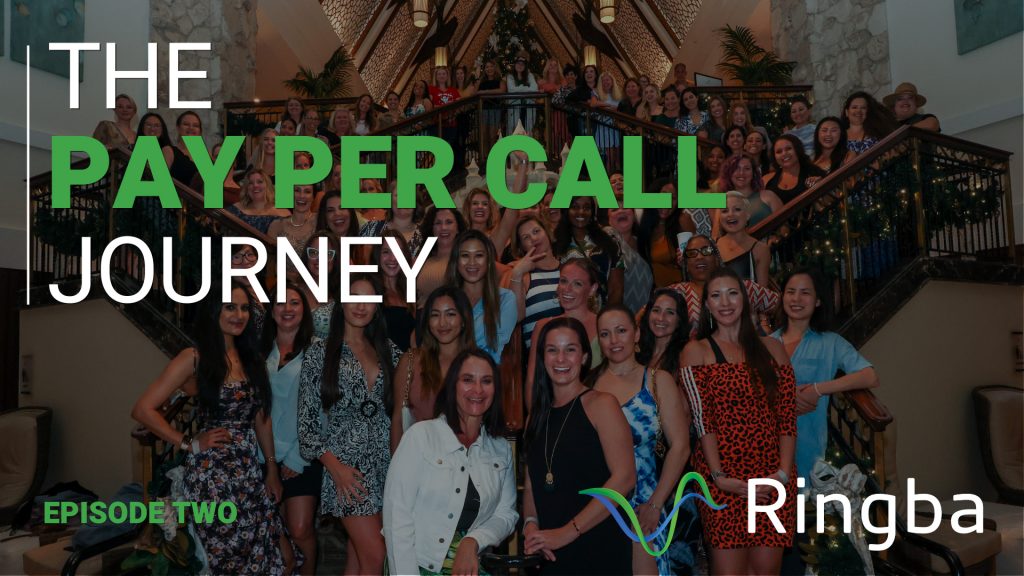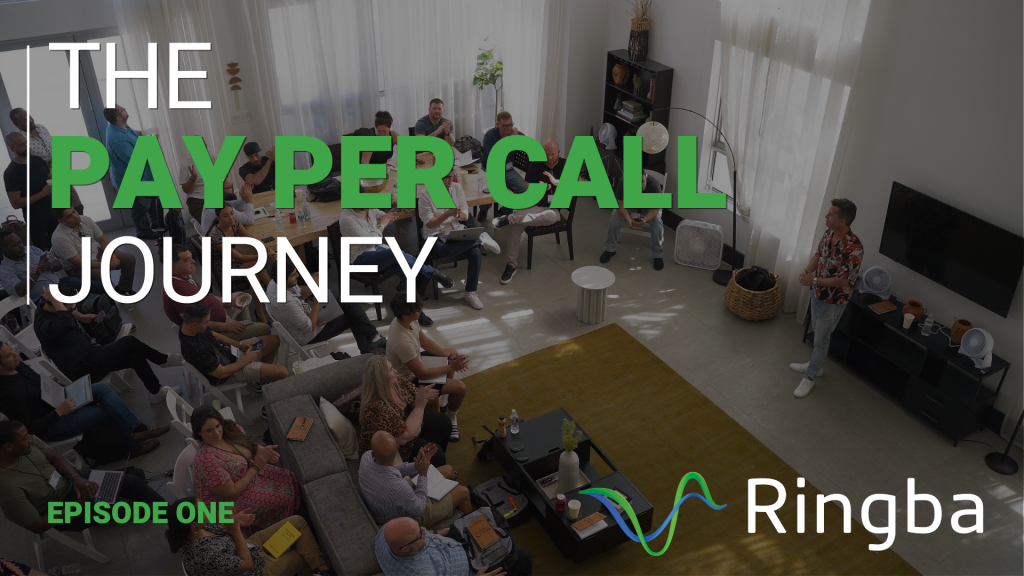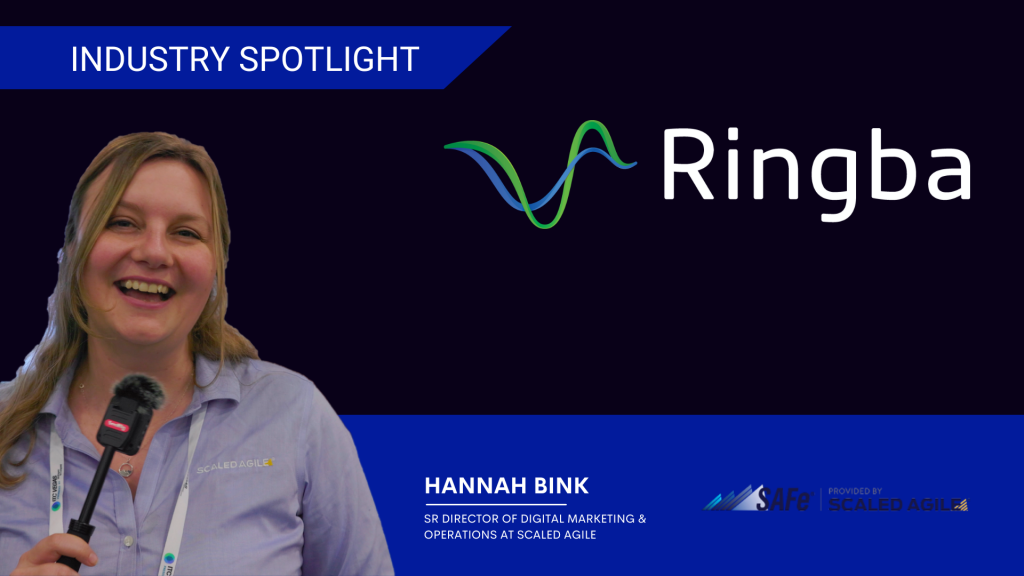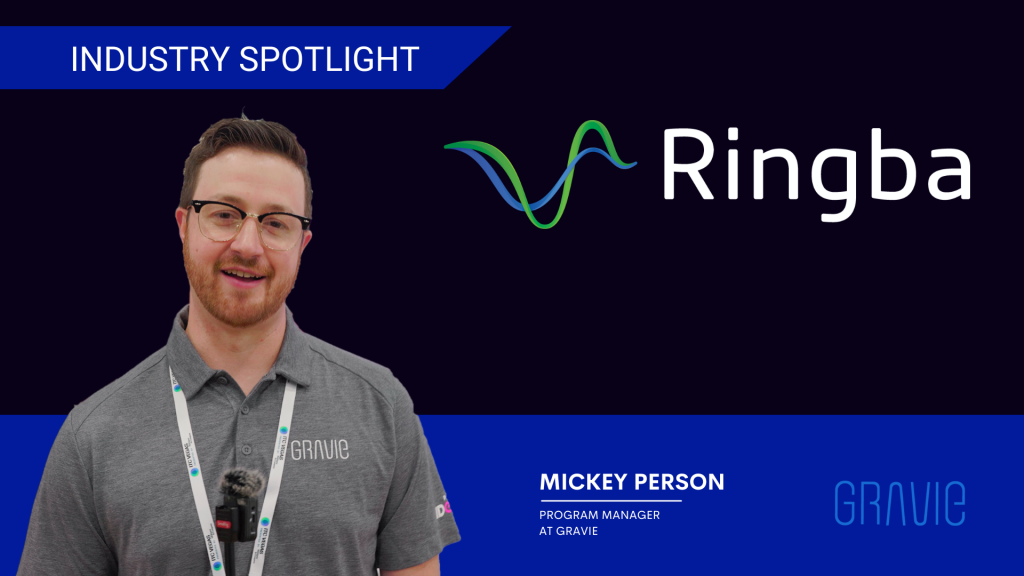Learn how to find local Pay Per Call buyers and create a step-by-step repeatable process for working with and onboarding new clients.
Contents:
– What is a Buyer Network
– Pros and Cons of Creating a Buyer Network
– How to Build a Pay Per Call Buyer Network
– Deciding on a Market
– Determining Lead and Call Pricing
– Making a List of Potential Buyers
– Finding Buyer Clusters
– Contacting Prospects
– Working with Buyers
– Creating a Repeatable Process
What is a Buyer Network?
A buyer network is a self-service or managed network of small buyers. That could be a dentist office or a chain of dentists or an insurance office, real estate office, eight or nine real estate offices, 600 real estate offices, whatever. Then, all combined in a buyer network that you’re going to load balance your calls through with technology.
Pros and Cons of Creating a Buyer Network
Let’s take a look at some of the pros and cons of creating a Buyer Network:
Pros
– Direct to the advertiser
– Massive competitive advantage
– Highest margins possible
– Build enterprise value
Cons
– Lots of business development
– Requires more onboarding
– Requires account management
– Requires accounting process
– Expect lots of hand holding
How to Build a Pay Per Call Buyer Network
A Pay Per Call Buyer Network is the best way to build a long-term and sustainable Pay Per Call Agency or Network. Let’s take a deeper look at how to build a self-serve pay per call buyer network:
Step 1) Use technology that can support it
First and foremost, I want to reiterate you have to use technology that can support it. If your technology does not support a self serve buyer network, well, you’re going to fail, you’re going to have to invest millions in your own technology, or you’re going to have all sorts of problems. I highly recommend you use Ringba if you’re going to do this. That’s a biased answer but, again, it’s the only software out there right now that actually can support a self-service buyer network that you can get, and we’re investing heavily into growing and improving that process right now. By the time you read this, there’s probably going to be weeks of or months of improvements in our technology, but we are going to be investing in this for the long term. I highly recommend if you’re going to do this that you use technology that already supports it. If not, you’re going to have to build your own. If you’re new, it’s going to cost you millions of dollars.
With ours, not only do you get the call tracking and all the IVR features and everything else that goes into it, our Ping Tree Technology, you can white-label the whole thing your own brand, so all your buyers see your agency or your brand, but it’s already functional for your own self-service buyer network. It’s up to you. Invest millions of dollars or use software that already exists. But you don’t have any other choice, so I highly recommend you work with us on this one.
Step 2) Decide on a market
Next, you’re going to decide on a market or geographic area. When you get started, you don’t want two dentists in Pittsburgh, one dentist in Los Angeles, one in Idaho. That doesn’t serve you well. You want to consolidate a market. You want to pick a specific geographic area and then go after it. Build multiple buyers in that area so it’s redundant and you can handle more capacity, and then scale that out over time so that you can effectively reach a state or regional audience which gives you a lot more value. It doesn’t do you any good to have a fragmented buyer network where your people are all over the place because unfortunately, most Pay Per Call Networks and affiliates and people you’re going to be working with cannot geo-target at a level that they should be able to. This is because of their technology limitation.
If you do find some great buyers and they are scattered around, talk to a Ringba rep because Ringba can route by ZIP Code which is an entirely different animal. We probably have clients that can drive calls into your self-service buyer network if it’s a bit fragmented. We can try and help you accommodate that. But, again, I don’t recommend it. I think that you really should focus on a specific market and that’s going to serve you well. You build your name. You build your name and a brand within a particular market, and then you can take it over. To be clear, in almost every single Pay Per Call vertical, all 300 of them in all thousand sub-verticals within them, no one is doing this well. In insurance, people are doing this pretty well. Some pretty big companies have made a business out of this, but almost everywhere else, everyone’s doing a crappy job. There’s a ton of opportunity with a self serve buyer network.
Step 3) Determine buy and sell lead and call pricing
Once you’ve decided on your market, you need to determine the buy and sell leading call pricing. You need to understand how much it’s going to cost you to generate a call, whether you do it on your own and by media or you do it through your portals, or you find affiliates, or you buy those calls from networks. However you’re going to buy the calls, you need to understand what your buy prices are going to be for all those things. You need to understand what your sale price is going to be. What are these dentists or tow truck operators, whatever they are, going to pay you per phone call? And, depending on your market, that price is going to wiggle around a bit because obviously dentists in Beverly Hills have a lot more money. You should take advantage of that. There’s a lot more competition in Beverly Hills than Kansas City for media. You should take that into account.
Step 4) Make a list of potential buyers
Once we know what market we’re going to work in, what buy and sell lead pricing and call pricing we have, we’re going to make a list of potential buyers. Just like anything else, we’re going to make our own list of potential buyers. There’s no reason to buy a database. There’s no reason to try and systematize this process at first. It is as simple as you opening up a Google Sheet and researching it yourself. I’m going to show you how to do it.
Step 5) Work a map like a territory and build clusters
Now that you have your territory laid out, you have your geographic area, you know who all your potential buyers are going to be, you work it like a territory. For those of you that are not traveling salespeople or have never done any door-to-door, aren’t salespeople in general, a region is typically assigned to a sales person, and then they work it. They make a list of all the potential customers in that territory, they visit them, and they build relationships over time, and they keep calling on those customers until they land them. It’s the same thing as any other type business development.
Step 6) Contact and sell prospects
Once you have your list and your territory built up, you’re going to contact all your prospects. This is just standard cold calling and sales. It’s not hard to do, but you probably should personally do it so you understand it and can write scripts and teach your team to do it and build a team around this. You need to do it yourself first so that you understand everything about it and then you can hire people to do it for you.
Step 7) Deliver calls to buyers
Next, we’re going to have to deliver calls to the buyers — people who paid us for phone calls. We’ve got to deliver. Don’t take a $10,000 prepayment from a dentist, you’ll probably never get one, but you can take a $200 payment from a dentist and drive them a few phone calls. It doesn’t need to be all at once — you can ease them into this and send them a few calls per day until you’ve proven the campaign works and you can ramp up your volume.
Step 8) QA calls on new buyers
You’re going to need to QA all the calls for all your new buyers. If you bring on a dentist office and you send them five calls, you absolutely need to QA all of them. All five. You need listen to every single call so you can see what their employees are doing when they answer the call. If their staff don’t understand what’s going on or if they don’t sell the customer, your new client isn’t going to want to buy any more calls from you. But if they sell 80% of the phone calls and they make a lot of money, they’re going to be really excited about buying more phone calls from you. It’s absolutely essential that you know what your clients are doing after you send the calls.
You’re not going to understand what caused that unless you QA the calls. This can get a bit sticky because doing quality assurance requires time, and you’re going to have to build a quality assurance team over time to do this. But it’s crucial because if you know your clients are closing these calls like wildfire, you can force them to bid against each other more for the calls and your margins go up. Again, you’re going to be putting in more work up front, but long term you can see huge benefits from doing the QA.
Step 9) Follow up on a set schedule to review results
We suggest that for every single new buyer you bring on into your buyer network, you say, “Look, we’re going to send you five calls, we’ll do it over the next four days. On Friday or Monday of next week, let’s do a follow-up call to review the results.” This way you can show them the direct value of your calls, provide feedback on sales agents and build a stronger relationship with your client. Regular check-ins and follow-ups are absolutely required if you want to keep your clients happy and keep them coming back for more calls.
Step 10) Expand into neighboring areas
Once you have a few buyers clustered into a small regional area, small city, or a small suburban area where there’s like 20 dentists, you start expanding to the neighboring regions. You start just really working and building a territory. As you build out one successful campaign, you can adapt it to new markets like clockwork.
Step 11) Create repeatable process and build team
While you’re doing this, you document it all, and then you create a repeatable process, and you build a team that does this for you. If you’re going to do dentists or towing or plumbers or anything else, you could have a biz dev team of 30 people. You could have your very own call center, virtually, doing nothing but calling companies like this and bringing them into your buyer network. Up front, it costs you a bunch of money, but once you have them on if you do this process right, you can make millions, tens of millions, or hundreds of millions of dollars just doing this process.
Deciding on a Market for your Buyer Network
When deciding on a market to build your pay per call buyer network, these are some of the questions you should be asking yourself:
What markets do you personally know / have lived?
When you’re first deciding on a market, you want to think about what markets do you personally know or where have you lived. This is the easiest way to do this the first time because you understand where the customers are located, you know the geography, you can build a territory, you understand how far people are willing to drive and you can look at a Google Map from above and see where all the dentists or all the plumbers are. It’s going to feel familiar to you. Any time you’re doing something new, you want it to feel a little familiar. It just helps you through the process.
Where is there a high concentration of buyers?
Then you’re going to want to look around the markets that you know and that you’ve lived to look for a high concentration of buyers. If you think that Cincinnati, Ohio is where you want to specialize and they don’t seem to have a lot of dentists for whatever reason, that may be troublesome. The good news is, though, most Pay Per Call verticals have a high concentration of these service providers everywhere in the United States. If you grew up in the middle of nowhere in Montana, there’s nothing wrong with that, big fan of Montana, but there may not be a concentration of buyers there so this may not be productive for you. You may have to pick another city.
What you’re looking for here is a city or a suburban area that has at least 10 or 20 buyers in it. If it only has two, well then your business is hinged on those two buyers. If you move out into surrounding geographic areas and you pick up some buyers where there isn’t a high concentration, that’s fine. I don’t recommend you start there because you’re going to have to do a bunch of cold calling.
Cold calling is just like internet marketing; some will, some won’t, so what. Someone else is waiting that wants what you have to sell. But you need multiple people because you should assume that people are going to tell you no. People are going to hang up on you, office managers won’t take your call. Whatever, it’s just part of the process and you need to expect and accept that up front.
Do any markets seem less competitive?
You’re also going to want to take a look at what markets in your general geographic area seem less competitive. This is simple. Any downtown market is going to be a lot less competitive, but there’s going to be a higher concentration of businesses and potential calls, so it’s a trade-off. But this is why I prefer suburban areas because a lot of these business owners in suburban areas aren’t getting bombarded with sales pitches. It’s going to be a lot easier to get the office manager on the phone.
Generally speaking, the farther out from an urban center or major city that you get, the easier it’s going to be to convert a customer. If you go out in the middle of nowhere, it may be straightforward to convert the one dentist out there but, again, you can’t build a network around that. We suggest that you start with suburban medium concentrated population locations.
Can you focus on higher income areas?
You’re also going to want to target geographic areas that have higher levels of income. Why? Simply because the service providers in those areas charge more money and their services will be more high-end. This ultimately means you can charge more for your Pay Per Call Services. For instance, if you go to a dentist that’s in an expensive area like La Jolla, California, they’re going to be doing a lot more than just general dentistry and discount cavity filling. They’re going to be using the newest medical procedures for dental and cosmetic dentistry; they’re going to have high-end clients, they’re going to have a much better experience for their customers, so they’re going to be charging their customers more money.
When they charge their customers 50%, 100%, 200% more money than Bob’s Discount Dentistry, they’re going to be able to pay you a lot more money for those calls. Granted it’ll cost you more to generate them, but theoretically, it should cost you a little more to generate them, you should be able to have a broader margin on those calls as well. You want to think about what the demographics are of the areas that you’re targeting, and you want to focus on at least middle-class demographics to get started. Maybe what you’re going to offer is better to lower class or upper class or whatever it is, but it’s just going to be easier to penetrate a middle-class market getting started. A lower class market’s going to have thinner margins, maybe higher volume, perhaps significantly higher volume, but you’re going to want to have your game tight before you move into those spaces.
Determining Lead and Call Pricing
This can get a little bit tricky, and it’s a bit of an art, but you can always ask someone else. That’s the easiest way to do it. Are there already networks in the vertical that you’re going to use? For instance, if you’re going to do dentists, well 1-800-DENTIST already exists and it does precisely this. All you have to do is call 1-800-DENTIST as a buyer or call Brighter.com or whatever it is as a buyer and ask for information like; “How much do you charge per call?” and, “How many calls per week can I get?”.
You want to look specifically for your market; “I’m calling about the Kansas City market or the Independence, Kansas market. I want to know what the calls are. Blah, blah, blah,” and then you say, “Well, we also have a location that’s in Tuscaloosa or whatever, Springfield, Missouri,” it just doesn’t matter. Whatever your market is, ask for different pricing in different markets. Maybe it’s the same. Perhaps it’s not, but this will give you an idea of how other companies are pricing based on geographic location, so you don’t have to do all of this on your own. You can go in as a buyer to someone else’s network like you own a dentist office or you own a towing company or whatever it is, and they’ll give you the information. When you have the information, you have a baseline.
If you don’t want to do dental, maybe you’re going to do cosmetic surgery, and that doesn’t exist in Pay Per Call, but it should. You don’t have a baseline. You call every single other medical network you can find and create a spreadsheet and then get an idea and then feel your way through it based on whatever information you get. You’re going to adjust your pricing, too, based on the competitiveness in the market. As it gets more centralized into an urban area, like a downtown location, you’re going to adjust for more competition. Or affluent regions are going to have more competition. You adjust based on your cost of acquisition as well.
Over time, you’re just going to have to work with your clients and let them know that their costs can change. Built into the agreement you write with the dentist office or the tow truck driver or whatever, you should tell them that the costs are going to change. If they want more calls, they can bid more money inside their account, or they can bid less or whatever, but you should never tell one of these companies that the price is going to be static because you’re doing yourself a disservice. As competition changes, you want to lift the price up. What will happen is these buyers start to become dependent on your calls for the growth of their business, so you are going to need to work those prices up over time.
If you have a glut of phone calls and no one to take them, you depress the prices so that they’re willing to buy a lot more phone calls so that you can spend your time adding more buyers into the fold. It’s a supply and demand market just like anything else. But you do want to set up front expectations with your buyers that you aren’t going to have static pricing. It’s not like you’re going to pay 30 bucks forever for these calls and we can give you more or less, it’s market and season driven, and it’s going to be a dynamic process from the beginning.
Making a List of Potential Buyers
How do we do this in practice? It may or may not seem simple, but I want you to know it is simple. The first thing we’re going to do is pop open a Google Map and pick the city we’re in. I picked Kansas City. I’ve never lived in Kansas City. I don’t even know much about Kansas City. I’m not sure, as an adult, that I’ve ever been there. But it’s completely irrelevant. I’m going to look at this map, and I see this whole thing as my first territory. When you look at a Google Map, the bigger the text, the more the population. If you look at this, you can see Independence and Overland Park are bigger, Lee’s Summit is bigger. You have Raytown and River Bend and Liberty and Gladstone and North Kansas City. They’re smaller. That’s based on the size of the area and the population, but this is how I’m going to work a territory.
I’m going to take a look at this, and I’m going to see all these little suburban areas. As I pan away and move further from the downtown area, there are just tons of suburbs all over. Each one of these cities, these suburbs, is a market in itself. What I’m going to do is I’m going to open a Google Spreadsheet or Excel or whatever you want to use, and I’m going to create a list of businesses that want to buy my calls or may want to buy my calls in a specific city. That’s it.
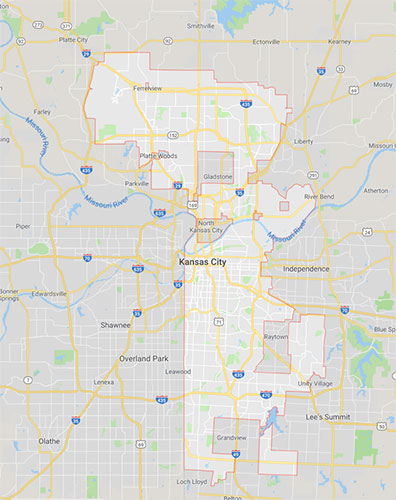
For this example, I picked Independence. Like, “Great. Independence sounds great, and that’s where we’re going to go.” It’s that simple. There’s no rhyme or reason to it. I’m just going to pick a more massive suburb. You could start with Shawnee or Overland or whatever. You could do the whole thing. It’s up to you. Yeah. It’s just that simple. You can hit this entire list in a day. You’re going to have to keep following up, but you can hit most of metro Kansas and get a general idea of how many buyers you can pull into the fold in maybe a week or two worth of work just you, and not full time, either. That is an exciting opportunity.
We already know we’re going to search in a specific geographic region you want to target. If I were going to be doing this, I would get real ambitious about it. I would find at least 50 plus targets. At least. Bare minimum. Why? Because I’m not going to pick up my iPhone and dial all of these people. I’m going to put them into a dialer, and I’m just going to hit it. I’m going to go. If I were going to do this, I would make a list of every single suburb and downtown in this in one shot. I would load it into a dialer, and then I would call them all and then I’d document the entire process and figure out how to sell these people in whatever field that I’m going to be choosing.
Now, if you don’t want to do this research and make this spreadsheet yourself, but realistically the entire Kansas City metro area can be documented in maybe three or four hours you should do it, you can hire a virtual assistant to do it for you. But then you are not going to get a feel for the area. You’re not going to get a feel for it. I highly recommend that you do an entire metro area yourself and just put the elbow grease in and do it so that you can build a process around it and then hire the virtual assistants to do the research and then eventually salespeople and the whole thing. You should document the entire process. If I were going to do this, I would record my screen, I’d take lots of screenshots, I’d write up a step by step guide, I’d make tons of meticulous notes, and I would create a step by step process that I can show someone else for this.
If you want to hear about people in Pay Per Call that build their own step by step processes, I recommend you watch the interview with Manny Zuccarelli on the Pay Per Callers Show. He’s the CEO of Quote Velocity is an entirely different animal than most people that are operating in this space. He is incredibly meticulous, is excellent about building processes. We talk about those processes on the show. He’s super detailed so that he can build a real business around what he’s doing. Please, watch that show, and you can hear about his process. It’s quality assurance, but the same type of thing applies.
You’re just going to record everything you do and create a process around it so that you can replicate yourself and have other people do this for you. Because if you’re going to get thousands of businesses in your buyer network, you’re not going to do that alone and you need to train the people that you’re going to have done it for you. You might as well do this yourself. You have to do this yourself if you’re small anyway, record and document everything. When you want to expand it, you already have the raw materials, you have to move around and do a training program, and you can train someone else to do it.
Otherwise, you’re going to have to have to do the whole damn process again yourself and document it or, like most businesses, you’re going to create piss poor documentation of the process. When you hire someone on, they’re not going to get the results you want or expect. You’re in a bad position and then a lot of entrepreneurs blame their employees for a crappy training process and not getting the results they want. But typically it’s the entrepreneur’s fault for not putting together an excellent training program. I’m a victim of this. I’ve put together training programs that didn’t get the job done before. That’s why I highly recommend that you record everything. It’s easy, it’s cheap, and then in the future, you can chop it up. You can have someone else edit it into a program, whatever you want to do. But then you have a training program. Just start doing that from the beginning.
Finding Buyer Clusters
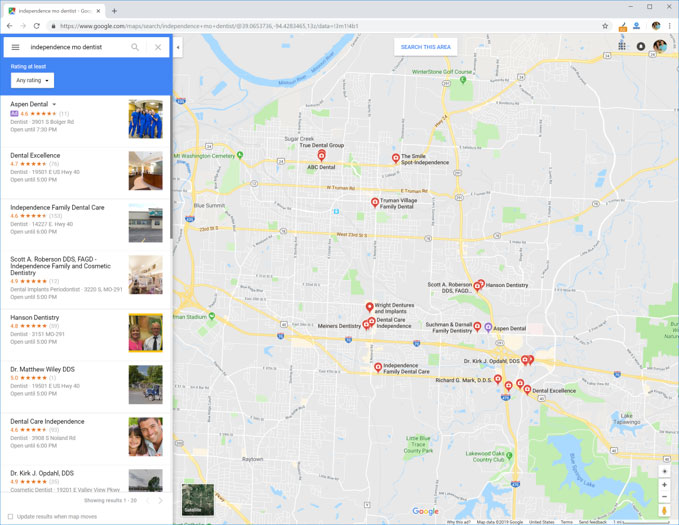
Now that we’re zoomed into Independence, we want to look for a cluster of businesses. You can see here on the map that this one’s good. It’s got pages showing results one through 20. There are multiple pages of dentist offices. You can see Aspen Dental here is advertising already, so they’re going to be a company that’s receptive to bringing in new business and growth. But, man, there are a lot of them. If you live in Independence, or even down in Raytown, all of these dental offices are accessible because, let’s see, from Raytown, how many we got, one mile? From Raytown, two, three, four, five to the farthest dentist office is let’s call it five and a half miles, not as the bird flies. Maybe six, worst case scenario. Someone will drive six miles to go to a dentist even if there’s one closer. This is an example of a great territory.
When I click next on here to show the next list, you see a bunch more dentists, and you can do this yourself. There’s like 60 dentist offices in the neighboring area of just Independence. That’s a lot of opportunities to find buyers. All these people are fighting over the customers, so they want your services. That’s an exciting opportunity. If you think that this is Independence and there 50 or 70 more metropolitan areas, man, that’s thousands of dentists just in Kansas City metro, that means there’s tens of thousands or a hundred thousand or more dentists nationwide, probably more, probably hundreds of thousands. All of them want calls every day. We’re talking about, with dentists alone, a multi-billion dollar opportunity for Pay Per Call. Hopefully, you understand the gravity of this simple business process that we’re talking about.
We’re going to work this as a traveling salesman. I’m just going to start from start to finish and copy every single one of these into a spreadsheet. I’m going to do their business name. I’m going to their address. I’m going to do their phone number. I’m going to do any other information that they have on their page, their website. I’m going to do everything. I’m going to get maybe their star rating, how many reviews they have in there because that information is vital in determining a budget. Independence Family Dental Care has 153 reviews; they’re mostly positive. That means they’re able to handle a lot of clients. Aspen Dental only has 11, but they pay for ads. That means they want to grow. That’s how I’m going to look at which targets are going to be the best.
Dr. Matthew Wiley DDS only has one review and is probably not a very big office. He’s not going to want to buy a ton of phone calls. Do you get it? I’m using the review volume and whether they advertise or not take a look at their potential budget because obviously, I want the buyers that can handle ten calls a day, twenty calls a day. But regardless, I’m going to call them all because maybe Dr. Matthew Wiley DDS can take three calls a week or five calls a week and he’ll pay $50 a call. It doesn’t matter. We’re going to do it all with technology. We’re going to manage all the capacity with technology so it’s irrelevant how many calls they buy and you want to get good at this.
This is what I consider a cluster. If I were to change the page, I’d get another cluster. But I want to work within a visual area of a map that makes geographic sense to a potential caller, which is a ten-mile radius at most. This is about ten from corner to corner. I’m going to call every single one, and I’m going to sell them. This isn’t complicated. You’re going to call the office, and you’re going to ask for the office manager. If they ask you why, you tell them, “I’m with a local agency. We specialize in dental marketing, and we have an overflow of calls. We work with a lot of your competitors in the area, but we have so many phone calls from people that want to go visit a dentist, they can’t buy them all, and I’d like to send you guys some.” That’s a bizarre phone call because of the way I positioned it. I positioned it as, “I have so many clients that your competitors can’t buy them all or handle them all, and so I need to talk to more dentists in Independence.”
It’s going to get the office manager on the phone. When I get the office manager on the phone, I am going to address this differently than a lot of people will because I believe in long term vision as opposed to short term gains. I’ll give them some free phone calls and then show them where the value is. But you have to decide how you want to do it.
Once you have a bunch of buyers in here, it’s going to be much easier to target calls in this geographic area. If I have ABC Dental and also Dental Excellence, I have ten miles in either direction of them, so a 30-mile radius that I can drive calls in. That’s really what I want is the physical geographic location. Coverage so that I can really, truly market and generate a lot of phone calls. I’m going to want a lot of buyers, especially in the same area, because whether I have the calls or not to support all these dentists doesn’t matter. Once they understand the value of those calls, I’m going to make them bid on those phone calls, and I’m going to start a bidding war because someone’s going to be willing to pay more than someone else for those clients. I want them to pay me the most. Bidding war only makes me more money. It doesn’t cost me more money. That’s what I want to do.
I also am going to want to implement Simuldial into this because I’m working directly to the advertiser. None of them are going to have phone systems. Those phones are going to ring until someone’s able to answer it. Simuldial allows me to dial ten different dentist offices at once automatically, and then whoever picks up the phone first gets the call. That may be counterproductive based on the bid, so I may create target groups based on bid levels so that I’m dialing three dentists at a time or whatever the case is, but I want to make sure those calls get answered, and no one drops them.
Contacting Prospects
Contacting prospects can be a complicated process. If you’ve never done cold calling before, I think you should do this to get the experience because most successful entrepreneurs have cold called at something. You have to, or you’re not going to win. For instance, I was a door to door salesman in downtown Detroit. I worked 100% commission in the winter selling phone service through bulletproof glass. It sucked, but what it taught me was how to be extremely resilient, not worry about getting told no, and to be a just absolute killer sales person. If you’re unsure about doing this yourself or you don’t like cold calling, get over it because it’ll make you a monster in business.
Also, how are you going to lead by example? If you can’t make cold calls and do this yourself, how are you going to expect someone else to do it for you, and how are you going to coach them? You’re not. It’s not going to work. Just don’t be lazy; get yourself a headset. You’ve got to be ready, you’ve got to love people. “No” is a buying sign. A no is a buying sign because they’re talking to you. Just get excited about doing it. Smile a lot. Get a headset so that you can walk around and talk like I am now because motion creates emotion. If you’re sitting in a chair like that and trying to give this class, think how boring this class would be if I were sitting down and giving it for, God, what are we at, 25 plus hours? Hell no. You wouldn’t watch it. You wouldn’t be engaged.
The same thing goes for sales. You need to stand up. You need to put a smile on your face, and you need to go. No matter what vertical you’re going to work in, you’re going to call all of them. No cherry picking, no whatever. Just call all of them. It doesn’t matter if it’s dentists or someone else, you’re going to ask for the office manager. Or in some scenarios, like towing, you’re going to talk to the owner or whatever probably. These are small business owners, their time’s valuable, make it quick and get to your value proposition. You can build a relationship, sure, but get to the value proposition. If they’re not available, ask their name, put it in your spreadsheet. Put it in your disposition report if you’re using software or dialer so that you know who to call back and ask for next time.
Then keep calling. Call on Monday; they don’t take your call, great. Call on Tuesday. Call Wednesday. Call Thursday. Call Friday. Don’t stop calling because there is no TCPA requirement for business. If they say, “Take me off your list,” take them off your list. Fine. I would say, if they told me to take them off their list, I’d say, “Whoa, whoa, whoa, wait a second. I’m not calling from a list. Hold on. Hold on a second. I work with your competitors in Independence. I need to talk to the office manager. I have something for them. I’m not even selling something; I’m here to give them something. Just chill out. I’m going to have to call back.”
And if they’re like, “No, take me off your list,” well then you need to. But I’m going to try and talk them into thinking that I’m here to give them something and not this instant take me off your list response. If they do that, just act confused like, “Wait, what? Wait, hold on. No, no, no, no, no. No, no, no, you’re not on a list. I’m not in a call center right now, and I’m not telemarketing. Listen, I need to talk to your office manager, it’s important.” And if you do that, most of the time the gatekeeper will transfer you because no one has the guts to do that. It puts you ahead of the game.
Also, they’re going to have emails on their websites. They’re going to have emails on their Google listings. Get that information and if they don’t talk to you, send them email advertising, too. Start building an email list and send them case studies and whatever. But the key here is the squeaky wheel gets the grease in any cold calling. You may not get them the first time, you will get them if you keep trying and what you have for them is something that they need and delivers excellent value.
That’s the thing. If you can help someone’s business grow, eventually they’ll listen to you and eventually they’ll become your client. That’s my philosophy with Ringba, and we’re exploding. Usually, we get told no the first time, that’s fine. We expect it. But once people realize that there’s more value there than they’re getting, they’re like, “Wait, I need to talk to them.” And this is the same thing. People want to grow their business. You have something to help them grow. You’re offering them something that helps their future. Invest in your future and give away some free calls.
“What, Adam, you’re crazy. Just giving away people free calls? I could sell those calls to a network, even. I could sell those calls, blah, blah, blah.” Because let me tell you, guys, if you call an office manager at a dentist office – If I were doing this myself, I would have a hundred people making these phone calls. But every single time we’d be giving away free calls. We’re like, “Look; we’re going to give you the first five calls free. They’re $50 apiece. That’s a $250 value. We have so many calls that we need a home for them. Listen, I’m not even here to sell. Take my five free calls. I’ll give you five free clients. No questions asked. Is that fine?” And the office manager’s going to be like, “Yeah, sure, what do we get to do?” I’m like, “You’ve got to do nothing. Nothing. We’ll make your phone ring five times, and I’ll call you back in a week, and I’ll let you know what happened.”
And they’ll be like, “Oh, okay,” a little confused, whatever. We’ll have a follow-up email, probably, that was like, “Oh hey, Judy. Thanks for talking to me today. Your five calls are going to start getting delivered during your business hours.” I would add the business hours into the spreadsheet so that the research doesn’t have to be done twice, and then our team can set up the hours of operation for the client. The hand holding we talked about. After they get the calls, I’m going to email her again, “Hey, you got five phone calls. Our quality assurance team listened to them. Did you know that your team closed four out of five phone calls? They got four new appointments out of five. Two of them were families. You got eight new customers and, from the sounds of it, you guys charge $350 a cleaning so there you go. I just gave you thousands of dollars worth of revenue. Can you spare 15 minutes to talk to me about it? Just want to review the results.” She’s going to be like, “Hell, yes.”
Or you can do it the hard way. You can call them up and say, “Hey, I’m Adam from Media Busters, and we specialize in dentists. I got a ton of phone calls. I have so many that I don’t have dentists to buy them, so we’re selling them at a discount right now. They’re usually $50. I can sell them to you for $40 a call; there’s a $250 minimum. Grab your credit card for me; this takes a few minutes to set up.” But then there’s a financial transaction there, and I may be a stone-cold killer at that, but the people I train to do it will take weeks or months to become killers on the phone. It’s better to give away the freebie.
What’s easier? Get your free trial of diet pills, only pay for shipping or give me $499? It’s the same thing. Invest in your future, give away some free calls. It’s going to open up every door. No dentist office or plumber or kitchen remodeler or whatever you’re doing is going to be like, “What? Free phone calls? That’s dumb. I don’t want those. Keep your calls.” No. No. They’re going to take the calls.
So, yeah, maybe you give away five free calls to a dentist. Your cost on them is 10 bucks a call, you’re in 50 bucks, the upside’s $250, you get them on it and the next thing you do they make a $4,000 prepayment for more calls at drastically higher margins than the network because you gave them a little bit of love for free. This is an easy sell if you do it right, guys. I’d be giving away $50,000 a day worth of free phone calls on a call center floor at scale because it would just be so much money in the upside. Just think about it. Even one guy in his mom’s basement can come up with 50 bucks to give a dentist office free calls. There’s no excuse not to use this model unless you can’t handle doing it the easy way.
Speaking of doing it the easy way, please don’t do this on your iPhone or your Android and manually typing phone numbers in there. Don’t do that. Get a Cloud-based dialer like Dialfire. Dialfire is great. No contract, no seat fee, usage-based just like Ringba. You don’t have to spend any real money, only deposit like 25 bucks, dump your phone numbers in there, get yourself a headset and go to town.
If you’re not going to take my advice and, as crazy as that sounds, 100% of people listening to this aren’t that try it, do me a favor and at least get yourself some earbuds so you can stand up and walk around while you’re talking to people. If you’re going to manually do this and waste your time, at least get yourself a headset. Don’t be the guy who’s like this and trying to sit at a desk and hold the phone and blow your shoulder out doing this. Don’t do it on speaker phone because you sound like a jackass. Just get yourself some headphones or a headset, or use a dialer and make your life easy. It doesn’t cost any money – a headset’s like 20 bucks on Amazon Prime.
Working with Buyers
I’m going to repeat this because I believe that it’s the way to do this. Give away for free to establish a track record. When you go to the store on free sample day, do you take the free samples? Yeah. Some people go to Costco on free sample day only for the free samples They end up buying a bunch of stuff. Because as humans, there’s the power of obligation. Someone gives you something for free; they feel obligated to reciprocate unless they’re a sociopath. 95% of the population, if you give them something for free, they feel compelled to reciprocate. If you give them five free phone calls that make them thousands of dollars, they’re going to take your call back, and they’re going to feel like they owe you to become their customer, to become your customer. They feel like they owe you. Giving it away for free is more than just your foot in the door, it’s almost a guarantee of success.
Now, the next one here is critical for two reasons. Bill buyers in advance, don’t issue credit for two reasons. One, people don’t pay their bills. Just because a guy has a beautiful dentist office with a grand piano that plays itself, and a waterfall and a 300 inch TV, and a Bentley parked out front does not mean that he pays his bills. Maybe his office manager sucks. Maybe he’s got a ton of debt. Maybe, maybe, maybe, maybe, maybe. Or perhaps he’s just a dirtbag. I don’t know. It doesn’t matter. Some people don’t pay their bills so make people pay you in advance. What you’re selling is worth its weight in gold so they should, especially if you gave them some freebies and proved it to them.
The second reason is if you issue people credit, then you’ve got to go collect it. You’ve got to call them. You’ve got to invoice them. You’ve got to blah, blah, blah, blah, blah. Giving people credit is not a good idea unless you hook up with a dentist office that has like 12 locations, and then you prove yourself, and they’re like, “Hey, listen, we’ve done $400,000 in business, can we get monthly terms?” Then the answer is, “Yeah. I will have an accountant work on that because I get paid $40,000 a month. Sure. No problem.” But if you’re dealing with a guy who buys four calls a week, do not issue credit. It will be nothing but a headache.
Then you want to get yourself a merchant account. Stripe, Square, Circle, I don’t know, hexagon, whatever shape merchant account you want. This is important so that you can bill people. You take their credit card; you make sure that they sign a form for it so they can’t charge back. You make sure you have an IO with these people that they understand they’re buying X number of calls for X dollars. They can eventually change their bid inside of the portal, whatever. You bill them with the credit card.
In 2019, something that’s on the Ringba road map is integrations with merchant providers so that people can log into your white-labeled account under your brand, put in their credit card, say they want 20 calls this week, and it automatically bills them like Facebook ads. That’s coming. I apologize at the time of writing this we don’t have that. Maybe by the time you’re watching this, it’s already there. Talk to your Ringba rep. They can let you know where it’s at or what’s released or where our self-service buyer features are. I’m sure we’re going to have tons of innovation by the time that you’re watching this simply because we do two pushes a week and this is a big deal on our road map.
You’re going to want to QA the buyer’s calls the first couple days or any new buyer. You’re going to want to do it on an ongoing basis. A lot of people that are watching this probably won’t follow all my instructions, and that’s disheartening, but I’m telling you right now, just let me give you the answer. Give people the free calls, QA those calls, call them back and sell them more calls, and then when you take their money, pre-schedule a review with them so that you can go over their process. Track their conversion rate, take notes on their pitch and then coach them and tell them which agents are better, which people are worse and help them close the calls. Because the higher the close rate, the more they’ll bid for those calls, the more you can create competitive pressure upward, and then you make more money.
As you go through this process, and you learn what works for you, and you learn what works for your clients, create a best practices guide and info for your clients. A one to three page PDF that gives them examples of what to do, how to do it, the best way to close customers, the best way to do these things so that they’re more successful. You need to invest in your client’s success because then they’ll keep buying from you.
Creating a Repeatable Process for your Buyer Networks
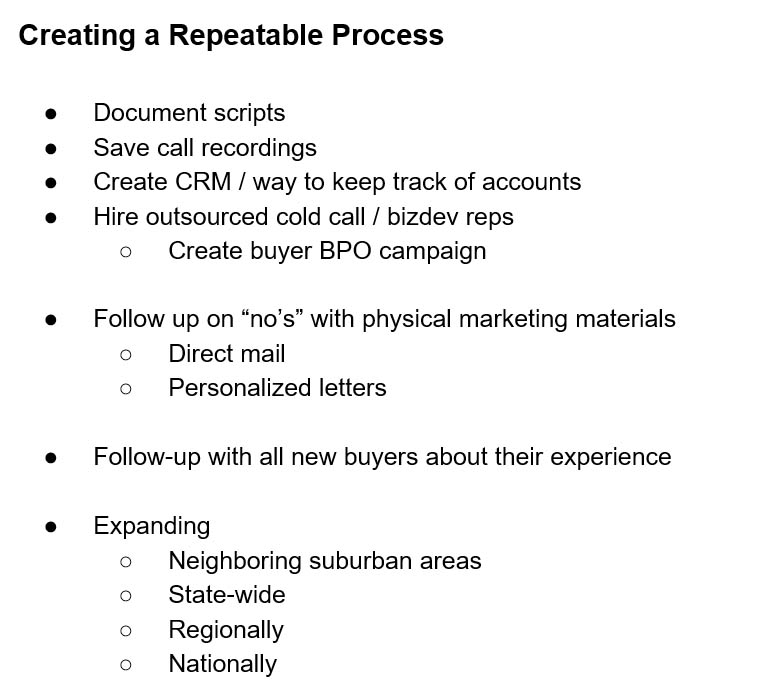
Once you’ve done all this, if you’re smart, you’ve recorded all of it. You’ve taken lots of notes. You’ve documented your scripts. You have every single call recorded. You’ve created a CRM to keep track of your accounts. What you’re going to do is take those recordings, your scripts, and you’re going to develop a training program for people to find more buyers for you. You can hire a BPO company or people in your office or a call center or build a call center or whatever you want to do to then repeat this process for you so that you can grow your business.
Any time someone gives you a no, you want to mark it in your spreadsheet or disposition it. You’re going to want your people to do this, too, as you grow so that you can reach out to them. You can create segments of people: nos, call me laters. Just like online marketing, you want buckets of users in different spaces in the process so that you can market to them differently. Direct mail is compelling. Do you know who the office manager is? Write her a letter. Do a personalized letter. There are all sorts of on-demand mailing companies where you can just API the information over, and they’ll send mail for you. Even a beautifully written letter with your logo on it signed by you in blue ink. It’s amazingly easy to do these things, and they’re very, very powerful.
And then you’re going to want to follow up with all new buyers about their experience. Maybe 30 days in, maybe 60 days in, maybe 30, 90, 120, whatever, maybe twice a year, perhaps once a quarter. You have to figure out what works best for you so that you can get their feedback on how you could improve the quality or problems they’re facing. After you develop a relationship with them, you’re a digital agency; you have all these buyers, maybe they got a crappy website, perhaps there are other things wrong with their business. By talking with them and following up with them and having thousands of people in your buyer network when you’re at scale, you will have the opportunity to take this information and create more service offerings to your already existing happy customers. That’s how you make a lot more money.
Now, once we’ve conquered Independence, then we go to neighboring suburban areas, then we statewide, we go regionally, then we go nationally. When we have a national network of call buyers in a specific industry, we can sell our business for so much money we don’t know how to spend it. That is precisely how you do this. It’s straightforward, start to finish.

